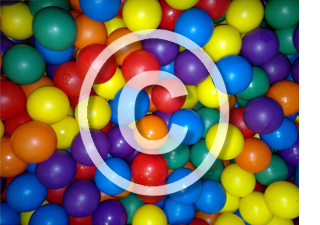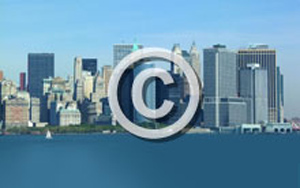Image Protection : Free Image Watermark Tool
 You can use this free online watermarking tool to copy protect GIF, JPG and PNG
images. Simply select the image from your computer to upload for our
server-side watermarking tool to overlay any copyright message that you nominate.
You can use this free online watermarking tool to copy protect GIF, JPG and PNG
images. Simply select the image from your computer to upload for our
server-side watermarking tool to overlay any copyright message that you nominate.
Image watermarks provide the best copy protection
for images that are distributed by email and shared on social media. Watermarks
are especially important for photographers. Overlaying a logo or photographer's
name onto an image is the best deterrent to plagiarism and image theft.



The Top Methods For Copy Protecting Images On Web Pages
These techniques to copy protect images are listed in order of effectiveness:
- Use a secure web browser designed to decrypt and display copy protected web pages.
- Use a copy protection plugin for web browsers to display copy protected images.
- Watermark branding an image with a message using tools like the one above.
- Using image encryption and browser plugin to display the image online.
- Splicing an image into segments and displaying them in a table set.
- Using a transparent overlay and the image displayed as a background cell.
- Using an image viewer on the page with either a Java applet or embedded Flash viewer.
- Preventing search engine and site grabbers from spidering media from the home page.
- Using link protection to protect direct linking to the image resource.
- Using html encryption to protect direct access to the image resource.
- Disabling the right mouse click menu to prevent image save and copy options.
- Adding a digital tag to an image using the Digimarc watermark plugin for Photoshop.
- Registering a digital signature for tracking on the Internet using image search services.
Protecting images published online (displayed on a web page) is very
different to distributing images for desktop viewing (email
attachments). Media displayed online can be protected by a variety
of methods, some of which can be most secure, because the
environment can be controlled by the web browser and browser plugin
used to display the image. The best software for
image protection is
the ArtistScope Site Protection System
(ASPS) which is installed server side, and
CopySafe Web which
can be used on any web page..
For offline viewing, watermarking may be the best choice, unless the images are
encrypted for viewing in a proprietary image viewer that can decrypt the images.
There are many different types of image file types, but they can all be added to
a PDF document which can then be copy protected using PDF protection software.
The best software to copy
protect PDF is CopySafe PDF.
Image Protection Techniques
 Copy Protect Web Browser
Copy Protect Web Browser
The ArtisBrowser includes all of the functionality of normal web browsers with the exception of those functions that enable site visitors to copy media from the web pages. Users do not have right mouse click options , cannot view page source to retrieve media links, and site grabbers and media downloaders are rendered useless because nothing can be retrieved from cache. Nor can packet sniffers trace media when the site uses the ArtistScope Site Protection System (ASPS).
 Copy Protect Browser Plugin
Copy Protect Browser Plugin
CopySafe Web provides both image encryption and copy protection while the image is on display. The CopySafe Web browser plugin is supported in all web browsers that support NPAPI plugins. Unfortunately Chrome is of no use with copy protected web sites, so visitors will need to use the ArtisBrowser.
 Image Watermark Protection
Image Watermark Protection
Watermarking is a most effective deterrent. Although it may not stop the physical copying of an image, no-one will want to use an image with your name on it. Images can be watermarked by using the tool at the top of this page. There are also many watermarking plugins available for popular CMS like WordPress that can watermark your images on the fly.
 Image Encryption
Image Encryption
While there are many image encryption solutions offered on the Internet, because they are limited to using JavaScript only, they do not offer very good protection because their encryption key is stored on the page. While other solutions based on Java and C++ cannot be decompiled. Secure Image Pro is based on Java and will run on any web page and is supported in all web browsers across all operating systems, ie: Windows, Mac and Linux. CopySafe Web is for Windows only and requires the ArtisBrowser but it provides the most secure image protection on the planet. With both solutions the images stored on the web server are even safe from your webmaster and web hosting staff.
 Segmented Images - Image Splicing
Segmented Images - Image Splicing
Image splicing cuts an image into sections that are then assembled in a tableset to keep them in place. Where image splicing can be effective is image thieves usually don't spend a lot of time copying or saving an image. So with a spliced image they will have to click and save each individual segment to save them to the computer. They may not notice until later that they only saved a portion of the images, and upon realizing that they will not only need to save each piece, but also have to put the puzzle back together before the image can be used. Some software is available that splices images automatically and adds them to temporary web pages complete with the tableset to keep them in place. Adding the tableset to your web page then only requires copy-n-paste. However in this day and age tables are not as commonly used and have been replaced with DIV sections that are not as visually friendly to work with.
 Transparent Overlay
Transparent Overlay
Using a transparent GIF or PNG image in a layer superimposed over the image is almost as annoying as spliced images to the would be thief who may not realize until much later that all he saved was a small clear image. The use of transparent overlays was first developed by ArtistScope in their research and development of copy protection for images on the Internet. At that time the greater population using the Internet were still using web browsers that did not support the position of layers. A more effective method so development moved onto image encryption.
 Applets and Flash Viewers
Applets and Flash Viewers
Displaying an image on a web page by using a Java applet or Flash viewer can prevent right mouse saves and image downloaders from locating the image resource. Secure Image (already mentioned above) was the first image protection solution ever available to the public. Some copy-cat solutions using basic applets were promoted as image protection but their effectiveness was mostly superficial because the image was not encrypted and was easily retrieved from page source. In fact saving a page with all contents usually rounded up everything including the so called "protected images" plus the code for their applets which were not domain locked and could be used on any web site that the thief chose. Flash viewers appeared later that used some encryption but today the popular browsers prefer not to support Flash on web pages any more.
 Search Engines and Image Grabbers
Search Engines and Image Grabbers
Usually everything is linked form your home page. So search engines and image grabbing software only needs to start at your home page and then they can spider each link, sifting through your HTML to locate your image files. Using NOFOLLOW and NOINDEX is usually ignored so unless you want to see your images in the public domain, you need to do something about it. If you are familiar with JavaScript or server-side programming language like PHP or ASP you can add some code to pages that check referrer to ensure that the page was visited from another link on your site. You can also check for session ID or cookies because most search spiders and downloaders do not support them. Or you check the user-agent of the visitor and check it against a list of known software. Or you can use link protection like below.
 Link Protection
Link Protection
Link Protect was another early development by ArtistScope that prevents image grabbers from spidering web pages to collect images. Link Protect used a CGI script that was supported on both Windows and Linux web servers. All links can be protected including images and other web pages. A normal site visitor can explore your pages and not notice the difference but when looking at the source code of a web page, the location of the images is not defined. The same applies to page links because images and pages can be stored in a secret folder on the web site that only the script knows. So the only way to visit a page or view an image is via the script. With Link Protect, even when clicking to save an image the script delivers an image of your choosing with a message for the thief. ArtistScope no longer support Link Protect because they have since developed more sophisticated solutions like ASPS. But today there are some PHP versions of Link Protect available on the web.
 HTML Encryption
HTML Encryption
HTML encryption can prevent direct access to pages and media while the visitor can be checked for browser type and password requirement before continuing. Software for HTML encryption appeared after image encryption. It is not as old as some makers claim because only the latest Netscape web browser could support the JavaScript that was used. That's right, another copy protect solution based on JavaScript and again, the key to unlock the encrypted HTML is stored on the very page that it is protecting [?!!!]. There have been some web page encryption solutions based on PHP and ASP but they require a higher skill set than today's web site proprietors possess.
 Disabling Right Mouse Click
Disabling Right Mouse Click
Right mouse click options can be disabled by JavaScript on your web pages. Those menu options provide the means to save, copy and paste selected text and images. So by disabling those options you are only going to slow then down because the same options are always available in a web browsers tool bar and by using keyboard keys such as Ctrl-C for copy and Ctrl-V for paste. There is also an option in a browser menu bar for saving the whole page complete with all components including images. But even with the right mouse click disabled, a user can still click on an image and drag it to their desktop. So why are there so many "image protection" plugins available for WordPress that do no more than disable right mouse click? Click to download one of the original No-Right-Click or No-Drag scripts.
 Digimarc Image Tag
Digimarc Image Tag
Digimarc is a system that applies a name tag to images (not a watermark as commonly described). It is mostly used by photographers when submitting digital portfolios because they can include their name and contact details. However it does not offer any protection at all which is contrary to what a lot of photographers have been led to believe. It is not visible on the image. The tag can be applied to an image using a photo editing software like Adobe Photoshop. But it can be easily removed in any image editor by saving it as a new image or exporting to a different file format. Or you can simply copy-n-paste the image to lose the tag.
 Image Tracking
Image Tracking
Image tracking services have been around for a while, mostly as paid services where you register your images and their search engine spiders the Internet to check for duplicates matching your digital signature. When a breach is discovered they can provide some advice and support in issuing "take down notices". Prosecuting or suing the offender is usually a waste of time because only small time offenders are likely to be found who probably won't be financial to justify your court costs. We have always consider that those who use such services must have more money than sense, because anyone seriously pirating images can easily evade detection by exporting the image to a different file format (PNG to JPG, etc) or by compressing the image the image. That way the "signature", which is basically the source code that comprises the image, will not be the same.